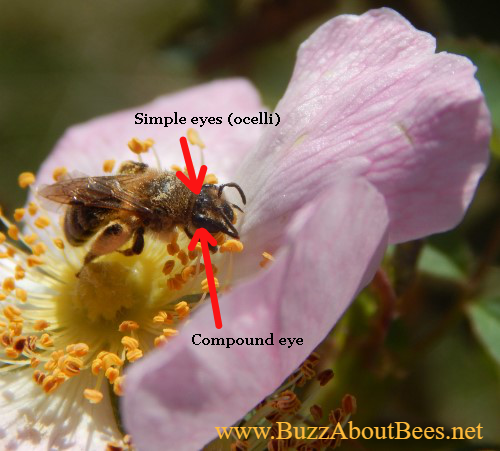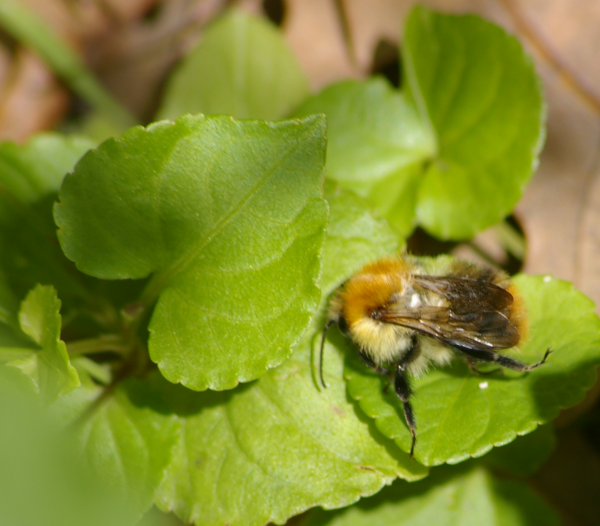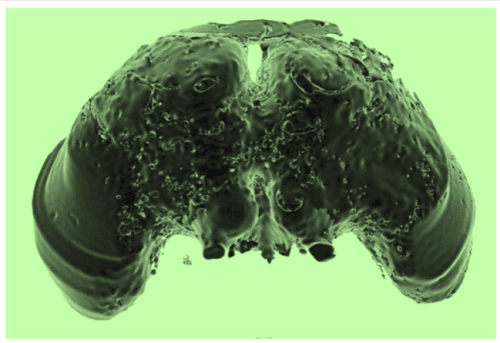Do Bees Fly At Night?
Can Bees See In The Dark?
Which Bees Are Active At Night?
People are often curious about the activities of bees at
night. This topic is the subject of
scientific investigation.
Here, I’ll
draw on some of the research (listed at the end of this page) to answer questions such as: Do bees fly at night?; Do bees have night vision and can they see in the dark?; and Which bees are active at night?
You might also be interested in the page Do Bees Sleep?
Do bees fly at night?
The short answer in summary...
- Yes, there are species of bees which fly out at night. They actively forage for food, and have evolved the ability to see and fly in the dark.
- The bees which can fly at night are mainly tropical species.
- Bees active at night gather nectar and pollen from flowers which are open at night time, and offer generous amounts of pollen and nectar. There is far less competition from other bees, butterflies and other insects for nectar and pollen from this night time nectar source.
- Bees which can see and fly in the dark have evolved slightly different eyes. Bees have 5 eyes, and the 3 ocelli are responsible for reflecting light. The ocelli on bees which fly at night are notably larger in proportion to their bodies, than is the case for bees that are active during the daytime.
- Some bees can tolerate different levels of darkness, but most seem to require at least some moonlight, or they fly out at twilight.
- However, an example of a bee which can fly out during complete darkness and without the aid of moonlight, is the Indian Carpenter Bee.
Below is further information to build on the basic facts outlined above - please see the end of this article for published research papers.
Are 'Night' And 'Dark' The Same Thing?
When we ask 'do bees fly at night' and 'can bees see in the dark', what do we actually mean by ‘night’ and ‘dark’?
'Night' and 'dark' mean different things to different people. Therefore, we should consider what we mean by night time, and whether we mean total darkness, or at least some light.
A creature may be nocturnal in its habits
(active at night), crepuscular (active during dusk and dawn – i.e. twilight);
or diurnal (active during the day).
Nocturnal = active at night
Crepuscular = active during dusk and dawn – (i.e. twilight)
Diurnal = active during the day
Most
bees are diurnal, however, there are exceptions, with a small number of bees
being crepuscular or nocturnal.
Nocturnal And Crepuscular Bees
As far as we are aware, nocturnal or crepuscular bees are mainly tropical species.
Interestingly, a number of tropical wasp species have also evolved this lifestyle. Such bees (and wasps) are able to fly and
navigate through a dark forest between their nest and target foraging site.
However, to quote scientist and researcher, Eric Warrant (see ref 1 below):
“Despite being nocturnal…..light levels– and by implication visual reliability – nonetheless limit foraging activity in bees and wasps active at night (Kelber et al., 2006). Some species are clearly crepuscular, requiring slightly brighter twilight skies to see well enough to negotiate obstacles during flight and to find their way home following a foraging trip. Those that fly all night often require the presence of bright moonlight.
Light levels are thus limiting – a species capable of visual foraging in the early dusk may be forced back to the nest just a short time later before light levels have become unacceptably dim.”
Nocturnal and crepuscular (dusk and dawn) foraging activity in bees has arisen independently in at least four of the seven recognised families of bees, namely in
- the Colletidae,
- the Andrenidae,
- the Halictidae and the
- Apidae families of bees.
(Hopkins et al., 2000; Wcislo et al., 2004; Taylor, 2007; Warrant, 2007).
Nocturnal Bee Species:
Nocturnal bees include:
- Megalopta atra (Halictidae; Augochlorini), from the Panamanian highlands) and;
- the Indian Carpenter Bee which is capable of flying out and finding its way even on the darkest nights, and even without the aid of moonlight.
Crepuscular Bee Species
Examples of species known to be crepuscular, include:
- Xylocopa tabaniformis (the horsefly-like carpenter bee or mountain carpenter bee),
- Xenoglossa fulva (a squash bee),
- Ptiloglossa guinea (a species of Colletidae plasterer bee),
- Ptiloglossa jonesi (a species of Colletidae plasterer bee),
- Ptiloglossa arizonensis (a species of Colletidae plasterer bee),
- Caupolicana yarrow (also from the Colletidae family),
- Caupolicana ocellata (also from the Colletidae family),
- Martinapis luteicornis (yellow-horned morning long-horned bee),
- Peponapis sp. (squash bees),
- Lasioglossum (Sphecodogastra) sp. (sweat bees),
- the Central American sweat bee Megalopta genalis
Megalopta genalis is active under the thick rainforest canopy during two short time windows shortly after dusk and before dawn.
The sweat bee Lasioglossum
(Sphecodogastra)
texana is primarily diurnal, but has been found to be capable of foraging at
night with adequate moonlight (as least half full moon).
How are the eyes of bees that see in the dark different from those of bees that forage in daylight?
Bees have 5
eyes:
- 2 compound eyes
These are made up of many hexagonal facets, meaning that they can simultaneously see all around them (above, below, side to side, and forwards). - 3 simple eyes (or ocelli)
The ocelli are 3 eyes positioned on top of the head. These eyes are sensitive to light, and aid the bee in its orientation.
You can read more about why bees have 5 eyes.
In night flying bees, the limited amount of light available, has resulted in the evolution of proportionately larger compound eyes and ocelli.
In particular, the three ocelli (which are sensitive to light) are significantly larger relative to body size in species that fly in dim light, compared with the ocelli found on daylight foraging (diurnal) bees (Kerfoot, 1967b; Kelber et al., 2006; Warrant et al., 2006).
For example, in the giant nocturnal Indian carpenter bee (Xylocopa tranquebarica) they measure almost a millimetre across, yet the ocelli of the similarly sized diurnal (daylight active) species X. ruficornis are significantly less than half this size.
The compound eyes are also a little larger in nocturnal bees, but the relative difference in comparison with diurnal species is less pronounced.
Do honey bees fly at night?
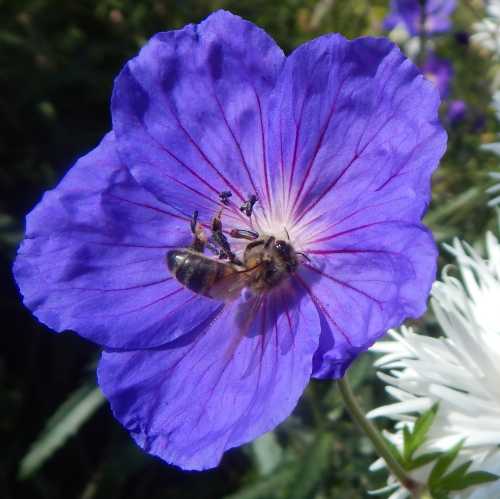 Above - Apis mellifera - the Western honey bee is diurnal (active during the day), but there are a couple of honey bee species known to be capable of flying out during moonlight.
Above - Apis mellifera - the Western honey bee is diurnal (active during the day), but there are a couple of honey bee species known to be capable of flying out during moonlight.Two species of honey bees (Apidae, genus Apis) are diurnal, but
– like Lasioglossum
(Sphecodogastra)
texana mentioned above, they are known to
be able to fly out if there is adequate moonlight, and these species are
- the giant Asian honey bee Apis
dorsata and
- the African honey bee Apis
mellifera adansonii.
Why are some bees active at night / in the dark?
Some of the reasons why a species may have evolved the
ability to forage at night or in non-daylight hours, are thought to be as
follows:
- Pressures from predators and parasites.
Bees foraging at night might be less susceptible to attack from parasites and predators, than those active in the day.
- Competition for limited food sources
There is less competition for food since there are fewer species active at night, competing for nectar from flowers. Bats and moths are the only notable competitors, rather than a vast number of different bee, butterfly, beetle and fly species (and birds).
- Flowering
pattern of local habitat in tropical regions, and in tropical forests
Specifically, some flowers only open at night, whilst some produce nectar both during the day and at night time, and in general, they produce a generous amount of nectar and pollen. Therefore, some bees needed to develop the ability to forage at night time in order to take advantage of the food source offered by these flowers.
It’s thought that the abundance of nectar and pollen reserves probably drove bees to forage at dimmer light levels, both later into the evening and earlier in the morning, when the nectar reserves of newly opened flowers are still relatively untapped.
- Dry environments
Some of the bees may live in dry environments, and flying during the colder morning and evening hours minimizes their loss of water (Hurd and Linsley, 1970).
Do bees sleep?
Apparently they do, but how do we know?
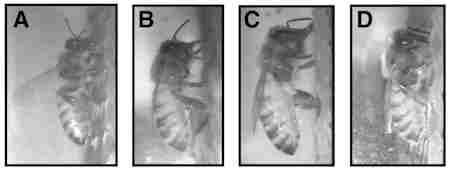
References:
- Eric J. Warrant; Seeing in the dark: vision and visual behaviour in nocturnal bees and wasps; Journal of Experimental Biology 2008 211: 1737-1746; doi: 10.1242/jeb.015396
- Almut Kelber, Eric J. Warrant, Michael Pfaff, Rita Wallén, Jamie C. Theobald, William T. Wcislo, Robert A. Raguso; Light intensity limits foraging activity in nocturnal and crepuscular bees, Behavioral Ecology, Volume 17, Issue 1, 1 January 2006, Pages 63–72
- Simon M. Tierney, Therany Gonzales‐Ojeda & William T. Wcislo; Biology of a nocturnal bee, Megalopta atra (Hymenoptera: Halictidae; Augochlorini), from the Panamanian highlands; Journal of Natural HistoryVol. 42 , Iss. 27-28,2008
If you found this page helpful or interesting, I'd really be grateful if you would share it with others - if not this page, perhaps another, such as Gardening For Bees.
Thank you so much :) .
